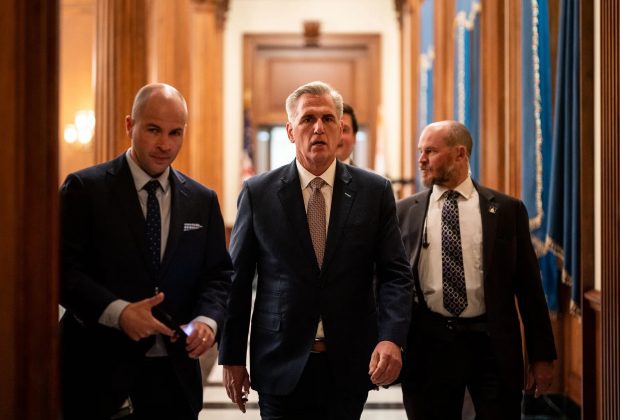Divided government is back, baby.
By Li Zhou | VOX | JAN. 3, 2023 | Photo by Kent Nishimura
After two years of unified Democratic control, a split Congress is upon us again in 2023.
This time, it comes in the form of a Democrat-controlled Senate and a Republican-controlled House. Both have their own policy priorities and are expected to clash over a series of must-pass bills on the debt ceiling, government funding, and agriculture policy. Because there’s likely to be little Democrats and Republicans agree on, each majority has signaled it plans to focus on what can be done unilaterally: Senate Democrats will be committed to advancing judges, while House Republicans have laid out a game plan for scrutinizing the Biden administration.
Below is a look at what both chambers could prioritize, and a glimpse of some longer-shot issue areas where they could collaborate.
What the House wants
House Republicans have been clear that investigations of Biden administration officials will be a central focus in the new term, and that they aim to home in on specific individuals, including Homeland Security Secretary Alejandro Mayorkas, who they claim has exacerbated the border security crisis. In a press conference last winter, some conservative lawmakers indicated that they were interested in impeachment, arguing that Mayorkas has not sufficiently deterred migrants at the border.
“If Secretary Mayorkas does not resign, House Republicans will investigate every order, every action, and every failure will determine whether we can begin an impeachment inquiry,” likely Speaker Kevin McCarthy (R-CA) said in November. Republicans’ targeting of Mayorkas, ultimately, would be more of a symbolic and messaging tactic. Even if they impeached Mayorkas, the Democratic-controlled Senate is unlikely to vote to remove him. Instead, any investigation or impeachment trial would function as a way to keep the issue of border security in the spotlight ahead of 2024.
Other issues that House Republicans have cited as key investigatory targets include the US withdrawal from Afghanistan, Attorney General Merrick Garland’s handling of the Justice Department, and the business dealings of Biden’s son Hunter Biden. Congress is limited in how it can follow through on investigations as lawmakers are unable to bring criminal charges, but they, as Democratic lawmakers recently did with former President Donald Trump, can recommend the Department of Justice bring charges. Failing that, lawmakers can draw negative attention to the administration, which could be valuable before the presidential election.
Beyond these investigations, McCarthy has laid out a legislative agenda called the “Commitment to America,” which sets up four pillars the party will focus on, including the economy, safety, individual freedom, and government accountability. Policies that are part of this proposal include everything from retention and recruitment bonuses for law enforcement to a parent’s bill of rights that supports feedback on school curriculums.
Of these proposals, Republicans have said that some of the earliest ones they aim to work on include bills that beef up border security resources like physical barriers at the southern border, and legislation that tries to roll back $80 billion in funding for the IRS that Democrats passed in the Inflation Reduction Act. Republicans have argued that these funds, which would hire tens of thousands more IRS agents, would be used to unfairly target people.
“On our very first bill, we’re going to repeal 87,000 IRS agents. Our job is to work for you, not go after you,” McCarthy has said.
Many of these bills will likely be stymied in the Senate, and McCarthy may have some difficulty getting these plans through the House, too. His narrow majority could make it tougher for the GOP to stick together depending on whether he’s able to get the most conservative and moderate parts of the caucus onboard. Doing so could prove particularly difficult with more contentious strategies, like impeachment of different officials.
What the Senate wants
One of the most impactful things the Democrat-controlled Senate can do on its own is to keep on stacking the courts with Democrat-leaning judges, after Republicans did the same for years during the Trump administration. According to progressive group Demand Justice, there are 69 judicial vacancies that do not have a nominee, as of late December, and 44 nominees pending confirmation.
Thus far, Biden has already seen the highest number of judges confirmed of any recent president at this point in their term, including one Supreme Court justice, 28 circuit court judges, and 68 district court judges. That number surpasses the more than 80 judges confirmed in Trump’s first two years. Biden’s nominations have also included a more diverse slate of nominees, featuring a higher concentration of women of color and public defenders. Democrats have a chance to continue this trend in the new term and expedite some of these confirmations.
While Sen. Kyrsten Sinema (I-AZ) has changed her party affiliation to independent, she’s said she does not intend to caucus with Republicans, meaning Democrats will likely be able to hold committee majorities in the new term. Having this majority could help Democrats more quickly move judges even in the case of tie committee votes. The Senate’s current 50-50 split has meant tie votes have required a special, more time-consuming procedure to advance to the floor. Now, even if Sinema doesn’t caucus with Democrats, the party will have a one-seat majority, giving it more sway over committee procedure.
Beyond judicial nominees, there are a lot of policies that Democrats were not able to get through by the end of the year that they could try to keep on pushing in the new term. One such proposal is a bill that would enable banks to work with marijuana retailers in states where weed has been legalized. That legislation was among those that lawmakers tried to squeeze into year-end spending legislation, though it was blocked by Republican leaders.
“It is bipartisan, it has the support of many different groups. We’re going to go back at it next year,” Senate Majority Leader Chuck Schumer said in a December press conference. This bill has also picked up bipartisan support in the House, a factor that could make it more tenable.
Immigration reform is another issue that fell by the wayside at the end of the year, which lawmakers have said they hope to revisit. A compromise on the matter has long proved elusive for Congress, and its chances remain slim in the face of House Republicans’ focus on making the subject a political wedge. Still, Sinema is among the senators who’s said she intends to try again in 2023.
“When we come back to Congress in January, one of the first things I’ll do with Sen. [Thom] Tillis (R-NC) is convene a bipartisan group of senators who are willing and committed to get something done,” Sinema said in a recent floor speech. In December, Sinema and Tillis released a compromise framework that included a pathway to citizenship for DACA recipients, as well as more border security resources.
The White House has also offered some early signs of the economic agenda that it hopes to push in 2023, much of which will encounter big challenges in a split Congress, too. Elements of that agenda could center on reducing child care and elder care costs for families, both subjects the administration previously fell short trying to tackle in reconciliation bills, and both which are aimed at boosting workforce participation.
“When we look at areas where we can make progress, one is on helping working parents,” National Economic Council Director Brian Deese told the Wall Street Journal. “Providing quality, affordable child care actually helps to reduce cost burdens on families and gets more people working.”
Other policies that Democrats have been unable to pass during their tenure, including an expanded child tax credit, could come up again, though most are set to have a tough time making more progress because of House Republican resistance.
Where the House and Senate will probably clash
There are a couple different must-pass bills that are set to fuel clashes between the House and the Senate.
Rep. Jim Jordan (R-OH) laid these out in an interview with Politico last October: They include the debt ceiling, government funding, and the farm bill, all must-pass bills to keep the US running, making each an opportunity for House Republicans to hold up legislation to make other demands.
Sometime in 2023, lawmakers will have to raise the debt ceiling, the amount that the US is able to borrow, with the potential for economic collapse if they fail to do so. Historically, Republicans have been more willing to risk a default on the debt ceiling, using Democrats’ fear of financial catastrophe to extract spending cuts. Republicans have already signaled a willingness to employ this strategy again, with McCarthy noting ahead of the midterms that there would be some requests made in exchange for GOP support.
“If you’re going to give a person a higher limit, wouldn’t you first say you should change your behavior, so you just don’t keep raising and all the time?” he told CNN. Some conservative House Republicans have signaled that they’re interested in more aggressive demands including possible cuts to Social Security and Medicare.
Government funding bills could be another inflection point for a standoff between the two chambers, with Republicans eager to curtail spending for social programs. If Congress fails to pass spending bills by October 1, the government risks a shutdown that furloughs workers and delays key services.
The farm bill, which conservative lawmakers have also withheld support for in the past, is a third chance for House lawmakers to extract concessions. Legislation that Congress has to renew roughly every five years, the farm bill authorizes many of the Agriculture Department’s programs, including SNAP. Previously, the Freedom Caucus sank a Republican farm bill in 2018 when they called for an immigration vote as a condition for its passage.
Where they could actually work together
The likelihood of passing more ambitious legislation, like the American Rescue Plan or the Inflation Reduction Act, is much lower in a split Congress, though there are still some long-shot areas both parties have expressed interest in.
One of these is permitting reform, which would expedite federal permit approvals for fossil fuel projects as well as clean energy projects, enabling them to get completed more quickly. House Republicans have cited the issue as a piece of their legislative agenda, arguing that the government is getting in the way of innovation and business. Democrats, meanwhile, have suggested that reforms are important to help put funding from green energy proposals and legislation like the infrastructure bill to use more quickly. Sen. Joe Manchin (D-WV) has made permitting reform one of his chief priorities as well, in order to approve the Mountain Valley natural gas pipeline in his home state of West Virginia.
This past year, permitting reforms failed due to outcry from progressives about the inclusion of guaranteed approval for the pipeline as well as attempts the latest version of the bill appeared to make to curtail community feedback on new energy projects. Republicans, though they’re also interested in permitting reform, largely opposed the measure because they weren’t interested in giving Manchin a win. The two chambers could try to work on a compromise next year, though some of those same outstanding issues could play a role again.
As Sinema alluded to, immigration reform is also an issue that remains on the table, with Democrats interested in prioritizing DACA recipients, and Republicans looking to beef up resources along the border. It’s long been a subject that lawmakers have struggled with in Congress, though they’ve said they hope to keep working at it.
Foreign policy is another area where there could be more bipartisan collaboration: This past year, the CHIPS Act, which is designed to invest in US supply chains so that the country can more effectively compete against the progress being made in other places, like China, was among the bipartisan packages that made it through. House Republicans have indicated that they’ll be focusing on scrutinizing the Chinese government, which could draw some Democratic support as well.
Backing for Ukraine as the Russian invasion continues has also had bipartisan backing thus far and could continue to see that, although a segment of conservative Republicans has begun vocalizing their opposition.
Despite these challenges, Schumer sounded a hopeful note at a December press briefing, “This is my hope and prediction: not all the Republicans are MAGA,” he said. “I intend to reach out both in the Senate, and even in the House to some of the more mainstream Republicans, and say, let’s work together.”







